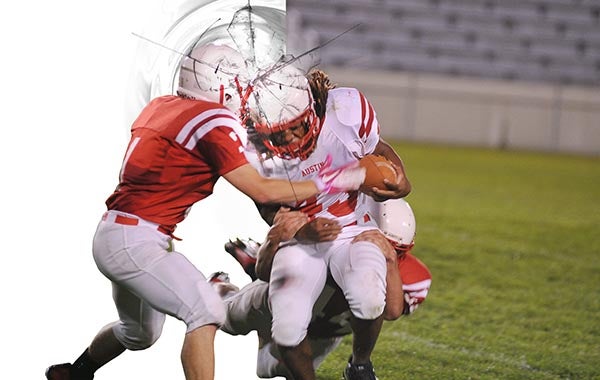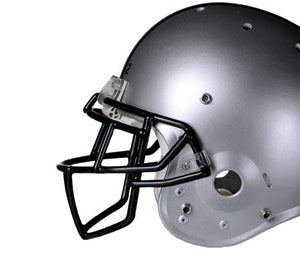A jarring trend
Published 12:00 pm Wednesday, August 29, 2012

As concussions garner more attention, coaches and medical officials are doing more to keep athletes safe. Illustration by Eric Johnson/photodesk@austindailyherald.com
They used to call it getting your bell rung or a jarring hit. Now the definition is a little more serious — it’s a concussion.
Concussions didn’t used to be considered possible unless someone was knocked out, but that’s changed. A concussion — a mild brain injury that occurs when a violent motion causes the head to move in a rapid position where the brain moves inside the skull — is more common in high school football than any other prep sport.
“Every person is different and every injury is different,” said Kris Dutton, a Certified Athletic Trainer with the Mayo Clinic Health System in Austin. “There’s things we look for like dizziness and vision problems. It used to be they just sat people [with concussions] out for a while, now we err on the side of caution and pull them out.”
Dutton, who has been an athletic trainer for 19 years, is at every Austin football game throughout the season and is available around practice time as well. Thanks to a new system AHS is starting this season, a lot of the work he’s doing on athletes with concussions has already begun, and will be ready when the Packers kick off their season 7 p.m. Friday at Red Wing.

Kris Dutton, A.T.R., A.T.C., a certified athletic trainer with the Mayo Clinic Health System Austin, walks among Austin football players taking the ImPACT Concussion Management test Wednesday morning at Austin High School. - Eric Johnson/photodesk@austindailyherald.com
Austin and other surrounding school districts like Southland and Blooming Prairie have recently begun initiating the ImPACT Program, which tests athletes on awareness, word memory and reaction time in 25 to 30 minutes over the computer.
When athletes are diagnosed with concussion-like symptoms, they have to take the test again to see how close they are to their original score, and to see if they can return to the field.
“It helps get rid of the gray areas,” Dutton said. “You can see if there’s still a little memory loss or if the reaction’s a little slower. I can give a judgment as to when they’re safe to return to the sport.”
AHS will use the ImPACT Program for varsity football and hockey this season, with the hope of eventually using it for all athletes.
BP head football coach Chad Gimbel said his football team will have a much easier time determining when to bring players back from head injuries because of the ImPACT Program. He also has seen diagnosed concussions increase in the last three years as awareness has raised.
“I think the medical field is doing a better job, and people are becoming more aware of the seriousness of concussions, especially with what the NFL has been going through,” Gimbel said. “Don’t mess with concussions. Football is today and your brain is for the rest of your life.”
Last year, the MSHSL made it mandatory for all high school football coaches to take a module that focused on recognizing concussions. Game officials now have the right to pull a player out of a game if there are signs of a concussion. The player won’t be able to return until cleared by a medical official.
With all of the talk of head injuries growing each year, it could be tough for some high school players to put on the pads. Austin senior linebacker Pat Wagner, who has played varsity football for three years, doesn’t let the fear of a concussion affect his play, but he’s well aware that it could happen.
“You just can’t think about it,” he said. “If you’re hesitant, you’re way more likely to get hit harder and get a concussion. I’ve seen people it’s happened to, but you can’t think about it.”
Sean Coffey, an AHS senior quarterback, said athletes must position themselves so they won’t take big hits to the head.
“I’ve been hit quite a few times, and I know how to protect myself,” he said. “I’ve been pretty lucky, too.”

Austin football player Gabe Gerstner watches shapes flash across a computer screen during a memory recall exercise as he takes the ImPACT test at Austin High School. The test acts is a baseline that can be used in the event that an athlete suffers a concussion. At the end of recovery the test can be taken again to evaluate progress of the athlete. - Eric Johnson/photodesk@austindailyherald.com
AHS head football coach Brett Vesel, who is in his first year with the Packers after coaching La Crescent for five seasons, said his first reaction when he sees a player with any concussion-like symptoms is to send him straight to the trainer. Vesel also said that concussions can occur on just about any type of play.
“My experience with it is, it’s when kids hit their head on the ground or other types of plays like that,” Vesel said. “It’s not the way we’re tackling, It’s other things like a [random] knee to the head.”
Dutton said it’s not just awareness about concussions happening. The game has evolved to a point where hits are getting harder. Dutton said out of the 400 to 600 athletes in AHS sports, he sees about 12 to 15 concussions per year.
“In the last 10 years, the velocity in all levels of sport has increased dramatically,” Dutton said. “A lot of the collisions are harder, and the equipment that’s out there is fantastic. But it can be timing, and it can be someone being out of position or someone hitting the ground; and they could get a concussion.”
The first 48 hours are an important time for a concussion victim, but it’s also the time after that which is key to recovery.
Dutton said no AHS athletes are allowed to compete until all of the concussion symptoms have been gone for at least a week. Still there is no magic number of days for when an athlete is over a concussion.
“There’s no real time frame anymore. It’s based on the athlete and the signs of the symptoms,” Dutton said. “I’ve had kids back playing in two weeks, and I’ve had kids take up to five months before they’re back. Each kid is different, and each time you’ve had a concussion, the likelihood of getting another one is a lot easier.”
With awareness of concussions being raised, Dutton’s job has become easier. It used to be if a player suffered a concussion in a big game, they may be encouraged to stay in and ‘gut it out.’
Those days are long gone.
“There’s no gray line with concussions. They will be pulled from competition,” Dutton said. “My job has been a lot easier to go to parents or tell kids that they may have this. Research has shown if we don’t look at the symptoms and don’t take care of it, it could affect you later in life.”
The stages of a concussion
•A football player is hit hard in the head and tries to shake it off. He’s still on the field but can’t focus on his opponents or remember the play calls.
•His head begins to hurt. After visiting the trainer, the player is diagnosed with concussion-like symptoms and is pulled from the game.

•The player recedes from physical activity, school, computers, television screens, video games and text messaging as he waits for his concussion symptoms to cease. When they do, he can begin his comeback to the field, which takes an entire week.
•The first step is to engage in light aerobic exercises like walking or cycling. The player may read 20 percent of normal volume and watch some TV.
•The next step is for the player to do sport-specific exercises with no-resistance training. He may read 40 percent of his normal volume, but still can’t play video games.
•The following step is for the player to participate in non-contact practice with resistance training. He may read 60 percent of the normal volume, but still, no video games.
•The last step before returning to competition is to participate in full-contact practice, read 80 percent of the normal volume and play some video games.





